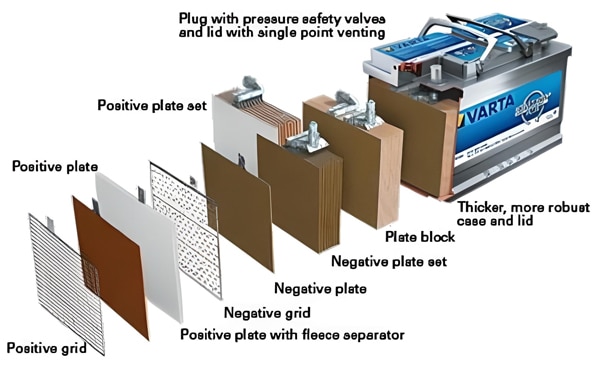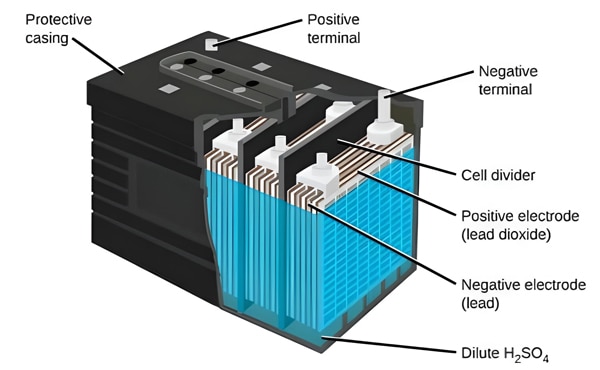Intro
The first AGM battery was patented by John Jossi on November 3rd, 1973. It is now one of the most popular types used today and an important component of any vehicle. They are designed to be maintenance-free and offer a powerful source of energy for vehicles that need it most, like those with large engines or high loads. These batteries are not the same as traditional lead-acid batteries because they do not require water topping up to function properly. Let’s take a look at what makes them so different!
What Is an AGM Battery?
AGM stands for absorbed glass matt, which is a method used to store electrolytes in the battery cells so they don’t spill out. These batteries are often used in applications that require deep cyclings such as golf carts, electric bikes, or solar energy storage systems.
How Does an AGM Battery Work?
An absorbed glass mat (AGM) battery is a type of lead-acid battery which uses a fiberglass mat to absorb electrolytes and improve its high rate of performance. As well, the construction of an AGM also makes it spillproof and leakproof compared with other flooded styles of lead-acid batteries.
They are similar to gel cell batteries in that they do not contain free liquid electrolytes like flooded or wet-cell batteries. They consist of preformed holes throughout the glass mats to evenly distribute electrolytes among all cells through special grooves in the glass mats.
AGMs are not like their flooded counterparts. The lead plates in regular flooded batteries are only about two-thirds submerged in the electrolyte; meaning that if you were to take one apart, there will be a dry layer of sediment on top of the plates. When a battery is in use, the sulfuric acid found in the electrolyte combines with the lead plates and releases electrons.
In AGMs, both plates are fully submerged in electrolytes. This makes it impossible to stratify when not being used and allows for maximum performance.
An advantage of gel cell batteries is they allow for high discharge rates. You can hook them up to a high-capacity alternator at full capacity instead of the standard one.
Gel batteries are also vibration resistant, which makes them especially useful for vehicles and applications where they will be jostled and bumped.
This is because they do not produce flammable hydrogen gas as regular flooded lead-acid batteries do. Instead, gel cells use silicas that absorb electrolytes and hold them in place.

AGM battery diagram
Pros and Cons of AGM Batteries
Pros
- AGM batteries are sealed and don’t leak acid like other types of lead-acid batteries.
- AGM batteries can be mounted in any position, whereas regular lead-acid ones need to be upright and it has shock resistance.
- AGM Batteries have a longer lifespan than traditional lead-acid ones. They have a long lifespan of 10 years or more.
- High-output power AGM batteries are suitable for higher starting power requirements.
- They have good discharge and charge efficiency. AGM batteries compared to flooded ones of a similar capacity can charge five times faster. When powered with the same charger and power source they have higher discharge rates that allow for quicker recharging time.
- AGM batteries are not sulfated. They can be stored for extended periods without needing a recharge due.
Cons
- The cost of an AGM battery is higher than traditional lead-acid ones.
- You may need to replace your charging system if you use an AGM battery because they require more current than traditional lead-acid ones.
- AGMs should not be stored at full charge for long periods of time as this will shorten their life span. This also means that they lose capacity over time.
Which AGM battery is right for you
Non-sealed, flooded batteries are well suited to deep cycling. These batteries require the user to check the electrolyte levels frequently to ensure they do not get dry and become ruined but can be bought in large capacities, so they will last a long time without being discharged. However, if you let them discharge too much or try to charge them too fast with a large charger made for quick charging you may damage your battery.
If you’re considering the purchase of a new battery there’s one thing that’s important above all others: Which type should you get? If it sounds like an easy question then think again: It isn’t! I’m going to compare two of the most common types of batteries, flooded (wet cell) and sealed (maintenance-free), in this article. Which is right for you? Which should you buy? Which battery type is best?
Let’s look first at some definitions:
Wet Cell Battery – also known as a “flooded” or “vented” battery. The wet cell contains liquid at all times which needs to be checked regularly. If it gets too low it can damage the plates inside the cells so adding water regularly is necessary until you reach full capacity. A wet cell battery has an open vent on top for hydrogen gas produced during charging to escape, which means they require the regular addition of water throughout their life. Wet cell batteries are not sealed so if you put in too much water or add contaminated water it can cause damage. Wet cell batteries come in standard, deep cycle, and starting varieties.
Sealed Battery – sometimes called “Maintenance Free” or “VRLA” (Valve Regulated Lead Acid). These types of batteries do not need maintenance or checking of electrolyte levels during their life. Sealed batteries are manufactured with vents that are either designed to recombine hydrogen and oxygen (these will be marked ‘desulphurization’) or which don’t allow gas to escape at all (in this case they may also be filled with an absorptive fiber that absorbs the excess gases given off when charging). Thus, there is no topping up of electrolytes or water required (so no need to mess around with distilled water) and you cannot spill liquid inside the battery.

Lead-Acid battery diagram
Related:
- How Long Do Car Batteries Last? When Should You Replace Them?
- How To Read Car Battery Date Codes? A Simple And Detail Instruction
- Can You Charge A Car Battery Through The Cigarette Lighter: Solution
- How To Disconnect, Replace Car Battery & Install A Car Battery
What are the risks of using a bad AGM battery?
If you do not maintain it correctly or charge it too much it will become ruined and unable to hold a charge. This means you will have wasted your money on purchasing such batteries in the first place because you won’t be able to use them anymore once they are ruined.
How to store your AGM batteries properly
How can we make sure our batteries stay healthy when we put them away for months at a time? Follow these tips:
- Keep batteries cool & dry (ideally, 40% charged or less)
- Make sure terminals are coated with petroleum jelly or a terminal protector
- Store batteries upright – ideally with some type of mechanical support to prevent damage vibration – NOT stacked one on top of another
- Use a dedicated battery room or location if possible
- Prevent contact with concrete or dirt floors, which can cause corrosion
- Keep batteries away from sources of heat and cold
And never forget the golden rules when it comes to battery maintenance: clean, charge, and protect.
Conclusion
The AGM battery offers many benefits over traditional lead-acid batteries because they are designed to be maintenance-free and offer powerful energy sources for your vehicles when needed. If you’re looking for a good all-around battery type, then AGM would be perfect for your needs!
Thank you for reading!
Further Reading:
WHAT'S NEW
The best AGM battery chargers will be the ideal option to revive your flat battery without relying on professional help. These handy high-tech chargers are extremely beneficial because they offer...
The Genius Boost GB40 is popular because of its ability to help boost your vehicle when it has battery issues. Many of our customers wonder why the Noco GB40 can work greatly like so. So, we have...

